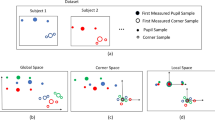Abstract
The main problem of a gaze-based interaction is the correct mapping from an output of eye tracker to a gaze point. In this paper we propose a new method of improvement of the gaze-based human computer interaction using: (a) a procedure to estimate the error introduced by screen tracking algorithms (surface recalibration) and (b) using the obtained error data to transform the eye-tracking data in real-time (data transformation). In order to test the developed method, we conducted initial pilot study using simple target pointing procedure. Initial data gathered during these tests shows that our method may increase the effectiveness (measured as target pointing speed) of the gaze-based interaction using mobile eye trackers. In future studies it is worth testing this method using stationary eye trackers as it can be an effective way of facilitating gaze-based interaction by counteracting calibration errors that would yield gaze-based system unusable.
Access this chapter
Tax calculation will be finalised at checkout
Purchases are for personal use only
Similar content being viewed by others
References
Feit, A., Williams, S., Toledo, A., Paradiso, A., Kulkarni, H., Kane, S., Morris, M.R.: Toward everyday gaze input: accuracy and precision of eye tracking and implications for design. In: Proceedings of the 2017 CHI Conference on Human Factors in Computing Systems, pp. 1118–1130. ACM, New York (2017)
Harezlak, K., Kasprowski, P., Stasch, M.: Towards accurate eye tracker calibration – methods and procedures. Procedia Comput. Sci. 35, 1073–1081 (2014)
Lander, C.: Methods for calibration free and multi-user eye tracking. In: Proceedings of the 18th International Conference on Human-Computer Interaction with Mobile Devices and Services, pp. 899–900. ACM, New York (2016)
Sugano, Y., Bulling, A.: Self-calibrating head-mounted eye trackers using egocentric visual saliency. In: Proceedings of the 28th Annual ACM Symposium, pp. 363–372. ACM, New York (2015)
Tripathi, S., Guenter, B.: A statistical approach to continuous self-calibrating eye gaze tracking for head-mounted virtual reality systems. In: 2017 IEEE Winter Conference on Applications of Computer Vision, pp. 862–870. IEEE, Santa Rosa (2017)
Kang, S.: Multi-user identification-based eye-tracking algorithm using position estimation. Sensors 17(1), 41 (2016)
Hornof, A., Halverson, T.: Cleaning up systematic error in eye-tracking data by using required fixation locations. Behav. Res. Methods Instrum. Comput. 34, 592–604 (2002)
Forget, A., Chiasson, S., Biddle, R.: Input precision for gaze-based graphical passwords. In: CHI 2010 Extended Abstracts on Human Factors in Computing Systems, pp. 4279–4284. ACM, New York (2010)
Vadillo, M.A., Street, C.N.H., Beesley, T., Shanks, D.R.: A simple algorithm for the offline recalibration of eye-tracking data through best-fitting linear transformation. Behav. Res. Methods 47, 1365–1376 (2015)
Špakov, O., Gizatdinova, Y.: Real-time hidden gaze point correction. In: Proceedings of the Symposium on Eye Tracking Research and Applications, pp. 291–294. ACM, New York (2014)
Kassner, M., Patera, W., Bulling, A.: Pupil: an open source platform for pervasive eye tracking and mobile gaze-based interaction. In: Proceedings of the 2014 ACM International Joint Conference on Pervasive and Ubiquitous Computing. Adjunct Publication, Seattle (2014)
Young, M.E., Crumer, A.: Reaction time. In: Vonk, J., Shackelford, T.K. (eds.) Encyclopedia of Animal Cognition and Behavior. Springer, Cham (2019, to appear)
Author information
Authors and Affiliations
Corresponding author
Editor information
Editors and Affiliations
Rights and permissions
Copyright information
© 2018 Springer International Publishing AG
About this paper
Cite this paper
Biele, C., Kobylinski, P. (2018). Surface Recalibration as a New Method Improving Gaze-Based Human-Computer Interaction. In: Karwowski, W., Ahram, T. (eds) Intelligent Human Systems Integration. IHSI 2018. Advances in Intelligent Systems and Computing, vol 722. Springer, Cham. https://doi.org/10.1007/978-3-319-73888-8_31
Download citation
DOI: https://doi.org/10.1007/978-3-319-73888-8_31
Published:
Publisher Name: Springer, Cham
Print ISBN: 978-3-319-73887-1
Online ISBN: 978-3-319-73888-8
eBook Packages: EngineeringEngineering (R0)




